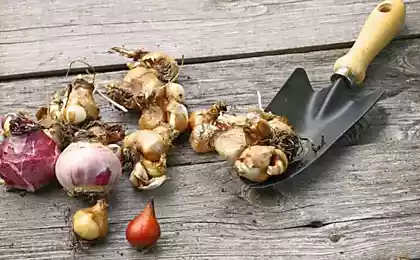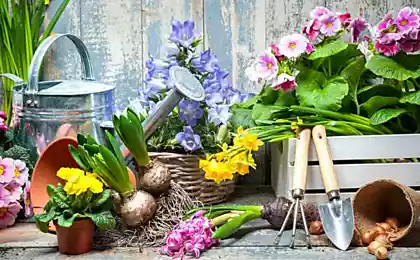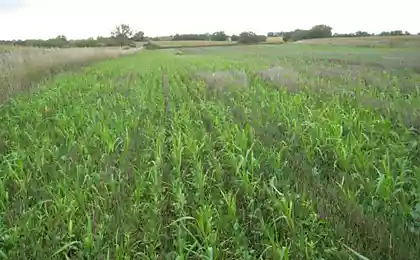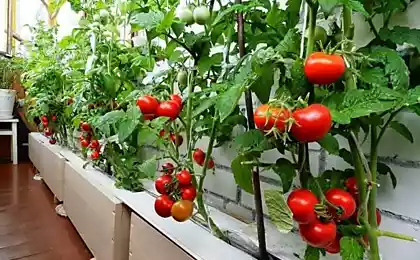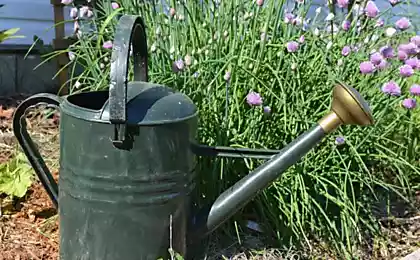601
How to know the soil type in your area and why
Question about types of soil many gardeners, especially beginners, seem to be "Chinese puzzle": it is not clear how this type is to determine and do, why do we need such complexity. Meanwhile, right here may be hiding the answers to many questions that trouble us.
Many years ago my first garden was built on a site near peat bogs. And I could not understand why I have beets growing. Excellent potato leaves, wild strawberries, raspberries feel great, happy greens, and beets can't even cry: a sad, sickly "tails", no matter how care. And it never occurred to me that this vegetable does not like acidic soil (and I was). Then decided — "not mine" plant. And then, in another country, grew up I have beet without any trouble and worries — just sow Yes proride time, and the autumn harvest pack.

In General, if brief, knowledge about the characteristics of different soils will help us with the selection of plants for the garden to be determined, and the proper methods and techniques for processing their plot to pick up. And, to go into some purely scientific details in this case is not necessary — to begin with, we will be quite the most General information.
The mechanical composition of the soil
This is one of the most important indicators, and at the same time is one of the most simple and to understand, and to determine.
The soil mechanical composition is divided into:
To determine the mechanical composition of the soil easily
To find out what is in the soil, take a handful of soil, evenly humidified it to the consistency it resembled a thick paste, and roll the "sausage" with a thickness of about 3 mm.
Then trying to roll her into the ring andsee what came of it:
— the soil is slipping, plastic ring folds easily and holds its shape clay, hard;
— the soil is rolled into "sausages", but crack when trying to put a ring on it — loamy;
— the soil crumbles, roll it from anything solid fails to lay down the ring impossible — sandy or sandy loam, easy.
This is a simplified version of the same loam, for example, is also divided into light, medium and heavy. But from the practical point of view we will be confident enough to navigate in these three types. Each of them has its pros and cons, and if the right approach to treatment, on the soil of any mechanical composition it is possible to obtain good yields.
Why is it important to understand? The mechanical composition of the soil determines its density, water permeability, water-holding capacity. Different types of soil different plants need is provided by batteries and require a different approach.
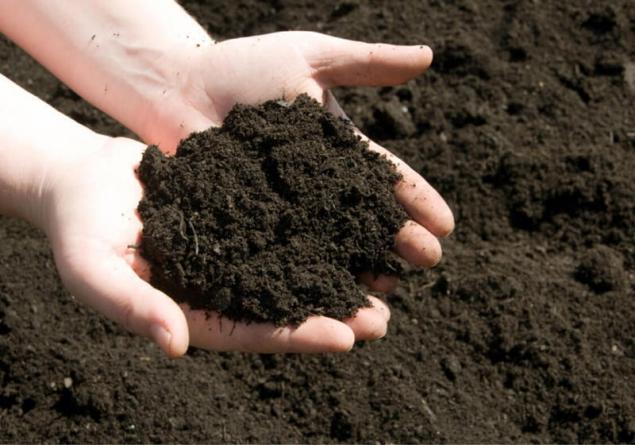
Different soils need different approach
So, heavy soils richer nutrition than light. But they quickly harden, after the rain the surface crust to harden. They often stagnant water, and suffer from waterlogging the roots of plants. In such soils poorly beneficial microorganisms, organic matter decomposes slowly, and therefore may be a shortage of supply. In the spring of plots with similar soil warm longer and melt water from them leaving later, so the landings have to start with some delay.
How to fix the situation? The main method is the introduction of disintegrating material (usually sawdust or sand). Sand can be made both in spring and autumn, but the sawdust — preferably in the fall, and before using them it is useful to moisten with solution of nitric fertilizers. The volumes and proportions are selected in each case depending on the requirements of the crops that will be planted, and the characteristics of the soil.
Well is also affected by sowing green manure; for sowing on heavy soils it is desirable to choose crops with a strong root system penetrating deeply into the ground (e.g. cereals).
Light soils do not hold water, and with water and losing nutrients. But they provide good air circulation and quickly warmed up in the spring.
"Heavier" the soil, increasing its moisture content can make clay or pond sludge (sapropel). The latter, however, requires pre-treatment: after the extraction it necessary to air and frozen to get rid of harmful for plants chemical compounds.
Useful on light soils the introduction of large doses of organic matter (rotted manure or compost). But peat should be used with caution: he has a good moisture content, but it can increase the acidity of the soil, and the nutrient content is not particularly valuable.
The acidity of the soil: how to identify and what affects
Another important parameter is the soil reaction. Why is it important? In the beginning, I have already cited an example of beetroot, which will not grow in acidic soil. And these plants a lot.
In General, there are 4 groups of crops, depending on their relationship to this factor:
— the first group of plants preferring neutral and slightly alkaline soil (pH of 6.0 or more): beets, pumpkin, zucchini, cabbage, onions and garlic, peas, beans, celery, cherry, plum and currants, daffodils, tulips, hyacinths, asters, carnations and others;
the second group plants that require neutral or slightly acid reaction of soil (pH 5,6-6,0): carrots, cucumbers, lettuce, cauliflower and kohlrabi, Apple, pear, begonia, gladioli, roses and other;
— the third group — plants, which favours slightly acidic soil reaction (pH 5.1 to 5.5): potatoes, corn, tomatoes, radish, raspberry, and BlackBerry, gooseberry, hazel, thuja occidentalis, irises, primroses, lilies, pelargonium and others;
— the fourth group of plants that prefer acidic soils (pH 4.0 to 4.5): sorrel, pine, azaleas and rhododendrons, heathers, Lily of the valley, lingonberries and cranberries, blueberries.
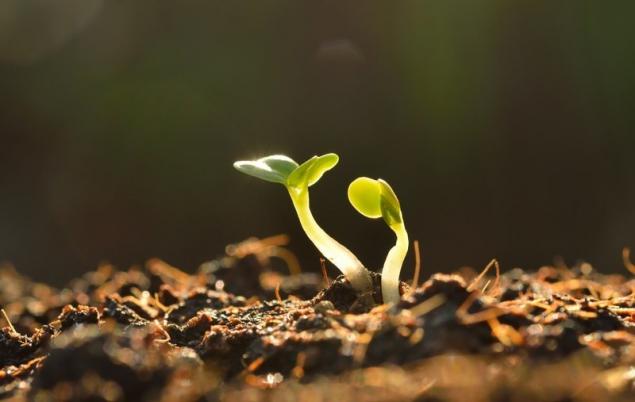
Each plant has its own soil
However, most cultures quite easily adapt to fluctuations in pH, and in special literature one can find contradictory information about the preferences of one kind or another. Typical calciferol (lovers of acid soils) and kaltsefily (those that prefer alkaline soil), relatively little. And yet, if planting does not take into account the requirements of the plant, is likely to lead to its disease, starvation, underdevelopment or death.
In soils with high acidity disrupted the nitrogen nutrition of plants do not get sufficient amounts of phosphorus, calcium and magnesium, because the content is not enough either, these substances are inaccessible to plants form. But there are other compounds that are toxic to the root system. Increased soil acidity triggers the disease because pathogenic microorganisms in such conditions develops faster.
However, an alkaline reaction is no better: here are the plants deficient in magnesium and iron, they turn yellow and the leaves fall. Unsuitable to the conditions of culture are ill, form deformed fruit, and often die.
How to determine the soil reaction
The most accurate and simple method is to pass the sample for analysis to a specialized laboratory. But this is not always possible, so do the means at hand.
A rough estimate can be given by typical land vegetation. But note: this method is suitable only in case, if you get virgin. On soils that have already been processed, plant — unreliable indicator.
However,
Carry out simple analysis
The soil is filled with water (10 g soil in 25 g of water; you can double the quantities if you prefer), thoroughly shaken or stirred and allowed to settle.
Then the extract obtained is lowered the strip of indicator paper and see what color it was painted:
Also interesting: Find out how to make the soil more fertile without chemicals
How to make soil fertile — simple tips
How to change the soil reaction
Since for most plants the favourable reaction is neutral, acid soils are limed and alkaline, on the contrary, acidified (however, it is much less).
For deoxidation of soil, use dolomite flour, lime (hydrated and quicklime), limestone flour and chalk. Suitable for this purpose and wood ash, which acts gently but effectively. Doses selected depending on the level of acidity and mechanical structure of soil.
It should be understood that the reaction of the soil is constantly changing, and single fertilization we solve the problem only for a while — check the pH of the soil preferably on a regular basis, but if you notice problems with the development of plants is the first thing that should be taken to find the cause.published
Source: vk.com/dacha.life?w=wall-83256656_28226
Many years ago my first garden was built on a site near peat bogs. And I could not understand why I have beets growing. Excellent potato leaves, wild strawberries, raspberries feel great, happy greens, and beets can't even cry: a sad, sickly "tails", no matter how care. And it never occurred to me that this vegetable does not like acidic soil (and I was). Then decided — "not mine" plant. And then, in another country, grew up I have beet without any trouble and worries — just sow Yes proride time, and the autumn harvest pack.

In General, if brief, knowledge about the characteristics of different soils will help us with the selection of plants for the garden to be determined, and the proper methods and techniques for processing their plot to pick up. And, to go into some purely scientific details in this case is not necessary — to begin with, we will be quite the most General information.
The mechanical composition of the soil
This is one of the most important indicators, and at the same time is one of the most simple and to understand, and to determine.
The soil mechanical composition is divided into:
- light (sandy and sandy loam)
- moderate (loamy)
- heavy (clay).
To determine the mechanical composition of the soil easily
To find out what is in the soil, take a handful of soil, evenly humidified it to the consistency it resembled a thick paste, and roll the "sausage" with a thickness of about 3 mm.
Then trying to roll her into the ring andsee what came of it:
— the soil is slipping, plastic ring folds easily and holds its shape clay, hard;
— the soil is rolled into "sausages", but crack when trying to put a ring on it — loamy;
— the soil crumbles, roll it from anything solid fails to lay down the ring impossible — sandy or sandy loam, easy.
This is a simplified version of the same loam, for example, is also divided into light, medium and heavy. But from the practical point of view we will be confident enough to navigate in these three types. Each of them has its pros and cons, and if the right approach to treatment, on the soil of any mechanical composition it is possible to obtain good yields.
Why is it important to understand? The mechanical composition of the soil determines its density, water permeability, water-holding capacity. Different types of soil different plants need is provided by batteries and require a different approach.

Different soils need different approach
So, heavy soils richer nutrition than light. But they quickly harden, after the rain the surface crust to harden. They often stagnant water, and suffer from waterlogging the roots of plants. In such soils poorly beneficial microorganisms, organic matter decomposes slowly, and therefore may be a shortage of supply. In the spring of plots with similar soil warm longer and melt water from them leaving later, so the landings have to start with some delay.
How to fix the situation? The main method is the introduction of disintegrating material (usually sawdust or sand). Sand can be made both in spring and autumn, but the sawdust — preferably in the fall, and before using them it is useful to moisten with solution of nitric fertilizers. The volumes and proportions are selected in each case depending on the requirements of the crops that will be planted, and the characteristics of the soil.
Well is also affected by sowing green manure; for sowing on heavy soils it is desirable to choose crops with a strong root system penetrating deeply into the ground (e.g. cereals).
Light soils do not hold water, and with water and losing nutrients. But they provide good air circulation and quickly warmed up in the spring.
"Heavier" the soil, increasing its moisture content can make clay or pond sludge (sapropel). The latter, however, requires pre-treatment: after the extraction it necessary to air and frozen to get rid of harmful for plants chemical compounds.
Useful on light soils the introduction of large doses of organic matter (rotted manure or compost). But peat should be used with caution: he has a good moisture content, but it can increase the acidity of the soil, and the nutrient content is not particularly valuable.
The acidity of the soil: how to identify and what affects
Another important parameter is the soil reaction. Why is it important? In the beginning, I have already cited an example of beetroot, which will not grow in acidic soil. And these plants a lot.
In General, there are 4 groups of crops, depending on their relationship to this factor:
— the first group of plants preferring neutral and slightly alkaline soil (pH of 6.0 or more): beets, pumpkin, zucchini, cabbage, onions and garlic, peas, beans, celery, cherry, plum and currants, daffodils, tulips, hyacinths, asters, carnations and others;
the second group plants that require neutral or slightly acid reaction of soil (pH 5,6-6,0): carrots, cucumbers, lettuce, cauliflower and kohlrabi, Apple, pear, begonia, gladioli, roses and other;
— the third group — plants, which favours slightly acidic soil reaction (pH 5.1 to 5.5): potatoes, corn, tomatoes, radish, raspberry, and BlackBerry, gooseberry, hazel, thuja occidentalis, irises, primroses, lilies, pelargonium and others;
— the fourth group of plants that prefer acidic soils (pH 4.0 to 4.5): sorrel, pine, azaleas and rhododendrons, heathers, Lily of the valley, lingonberries and cranberries, blueberries.

Each plant has its own soil
However, most cultures quite easily adapt to fluctuations in pH, and in special literature one can find contradictory information about the preferences of one kind or another. Typical calciferol (lovers of acid soils) and kaltsefily (those that prefer alkaline soil), relatively little. And yet, if planting does not take into account the requirements of the plant, is likely to lead to its disease, starvation, underdevelopment or death.
In soils with high acidity disrupted the nitrogen nutrition of plants do not get sufficient amounts of phosphorus, calcium and magnesium, because the content is not enough either, these substances are inaccessible to plants form. But there are other compounds that are toxic to the root system. Increased soil acidity triggers the disease because pathogenic microorganisms in such conditions develops faster.
However, an alkaline reaction is no better: here are the plants deficient in magnesium and iron, they turn yellow and the leaves fall. Unsuitable to the conditions of culture are ill, form deformed fruit, and often die.
How to determine the soil reaction
The most accurate and simple method is to pass the sample for analysis to a specialized laboratory. But this is not always possible, so do the means at hand.
A rough estimate can be given by typical land vegetation. But note: this method is suitable only in case, if you get virgin. On soils that have already been processed, plant — unreliable indicator.
However,
- on acid soil will show moss, sedge, horsetail, sorrel;
- a symptom of the neutral soil reaction are the mother-and-stepmother, clover, goutweed and nettle;
- on slightly alkaline soils grow quinoa and wild mustard
Carry out simple analysis
The soil is filled with water (10 g soil in 25 g of water; you can double the quantities if you prefer), thoroughly shaken or stirred and allowed to settle.
Then the extract obtained is lowered the strip of indicator paper and see what color it was painted:
- red — high acidity
- orange — srednekislye soil
- yellow-orange — mild acidity
- yellow-green — neutral reaction
- greenish-blue alkaline soil.
Also interesting: Find out how to make the soil more fertile without chemicals
How to make soil fertile — simple tips
How to change the soil reaction
Since for most plants the favourable reaction is neutral, acid soils are limed and alkaline, on the contrary, acidified (however, it is much less).
For deoxidation of soil, use dolomite flour, lime (hydrated and quicklime), limestone flour and chalk. Suitable for this purpose and wood ash, which acts gently but effectively. Doses selected depending on the level of acidity and mechanical structure of soil.
It should be understood that the reaction of the soil is constantly changing, and single fertilization we solve the problem only for a while — check the pH of the soil preferably on a regular basis, but if you notice problems with the development of plants is the first thing that should be taken to find the cause.published
Source: vk.com/dacha.life?w=wall-83256656_28226








